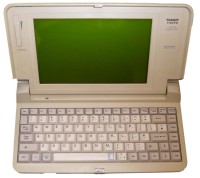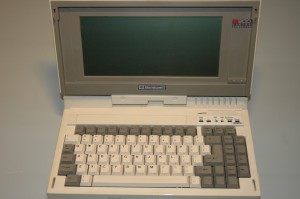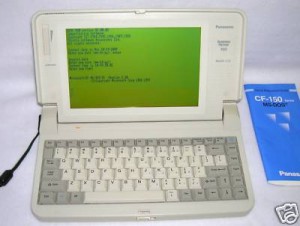This is a tale of delight and woe. This is the saga of a flirtation which led to a romance, which led to a long-term commitment, and which then devolved into a possessive compulsion. This is a story of tools which refused to remain just tools in my mind, but which became obsessions.
This is mania. This is collectivitis. This is me blowing wads of money out my ass.
This is the story of how I purchased my first laptop computer, broke it, bought another, and then bought two hundred and fifty more; how I planned a business and then abandoned it; how I was saved from my mania by the love of a good woman; and how, ultimately, I gave away more than half the laptops for nothing–and was happy to do so.
Now the story can be told.
* * * *
Six thirty-five PM on a Monday in April, 1990. I was fighting the Long Island traffic, perilously close to running late for dinner. And not just any dinner–my buddy Charlie’s family, the Pellegrinos, had invited me over for one of their Italian feasts. Being a bachelor of twenty-five, living on the North Shore of Long Island without any nearby family, subsisting mainly on subs from Blimpie’s, Chinese take-out, and Lean Cuisine, I never passed up the offer of a home-cooked meal.
Aside from the clotted traffic, the biggest obstacle to my being on time was the fact that my route between my two-room attic apartment and the Pellegrinos’ house took me right past a Radio Shack. And not just any run-of-the-mill Radio Shack, but a Radio Shack with a Computer Center, conveniently and seductively open until seven PM.

It was a boxy little storefront stuck between a fabric shop and a King Kullen Supermarket in a nondescript suburban strip-mall. But that deceptively plain Radio Shack snagged me with an invisible lasso as compelling as Wonder Woman’s. I couldn’t be certain, because not every store carried them in stock, but it might be there. It–the little machine I’d been flirting with for weeks. . . the six-pound hunk of plastic, metal, and silicon that had dominated my daydreams ever since I’d learned it existed.
It was a Tandy 1100FD notebook laptop computer. Tandy, corporate parent of the Radio Shack chain, had been a pioneer in the nascent field of consumer-oriented portable computing, ever since their introduction of the Radio Shack TRS-100, that battery-powered proto-tablet beloved by journalists. Until now, however, they had been an also-ran in the area of IBM-compatibles in general and IBM-compatible portables in particular, having fielded such uninspiring machines as the Tandy 1400LT, a fourteen-pound “laptop” that ran off two 3.5″ 720K floppy drives.
The Tandy 1100FD marked a departure for Tandy and for the computer industry in two vital aspects. One, it was small–a feather-weight for the time at just over six pounds. And two, it was cheap–Tandy pegged the retail price at the magical level of $999, and an adventurous shopper could get it as low as $849 if he were willing to run the risks of going the mail-order route. By way of comparison, the typical laptops of the time, from vendors such as Zenith and NEC, weighed upwards of ten pounds and cost upwards of $2,500.00. That’s in 1990 dollars, folks.
Sure, the 1100FD had its limitations. Its only drive was a single 3.5″ 720K floppy, and it had a non-backlit CGA screen. But to balance things out, Tandy installed their DeskMate suite of productivity applications in ROM (Read-Only Memory). Yes, DeskMate’s applications were nothing to write home about, even for back then, but it was the thought that counted. Plus, the non-backlit screen meant that the unit’s primitive lead-acid battery could last three hours or more between charges (so long as you didn’t back up your work to that single floppy drive too often).
I checked my watch again. 6:38 PM. I was only running eight minutes late (so far), and the Pellegrinos lived in the subdivision right behind the strip shopping center. I could spend two minutes parking, five minutes checking out the computer, and another two minutes driving to dinner and still be only seventeen minutes late. I was Jewish, the Pellegrinos were Italian–given our shared Mediterranean ancestry, seventeen minutes late could be considered right on time.
I was being rude, of course. Rude and pathetic, in a nerdy sort of way. But I was smitten, and being smitten makes idiots of the best of us. I just had to see that little machine again. I had to hold it in my hands once more, heft its lightweight chassis and marvel at how portable it was. . . I had to stare deeply into that brightly reflective lime green screen and daydream about all the stories, plays, and books whose words I would someday send dancing across it, little battery-powered photonic units of brilliance.
The store had one (just one) in stock, sitting on top of a glass display case like a little plastic prince. I spent ten minutes playing with it, instead of the five I’d allotted myself. And no, the Pellegrinos didn’t even realize that I arrived late.
* * * *
Oddly enough, after all my extended flirtation with the Tandy, all that drooling and caressing and fantasizing, I didn’t end up buying one. Truth be told, I was not a faithful admirer; the Tandy 1100FD was one of three candidates competing for my hard-earned New York State Office of Mental Health paycheck. The other two contestants were the Bondwell B200 and the Panasonic Business Partner CF-150B. The Tandy just happened to be the most accessible, since the commissioned sales guys at my local Radio Shacks were only too happy to let me play with their machine for hours on end, envisioning, I suppose, a five percent cut of my $999.
The Bondwell I happened to chance upon in, of all places, Sears. Many corporate reconstructions ago, before “the softer side of Sears” became the store’s main focus, Sears used to cordon off a section of their standard stores and call it “Sears Brands Central,” their little ghetto for all their home and office electronics merchandise (plus washers and driers and stuff). I think the reason I was browsing at Sears (not something I’d ordinarily do) was that my brown and gold S-10 Blazer had been stolen from the parking lot of the Long Island Railroad’s Huntington Station (by joy-riding punks who later dumped it when it ran out of gas, after tearing up the interior like a pack of Tasmanian devils). I was at Sears to rent a car.
The Bondwell wasn’t a bad little machine. It was just a little larger than the Tandy, and in its favor, it ran off two 720K floppy drives, not just one. Not only that, it was a couple hundred dollars cheaper than the Tandy. A no-brainer, right? Twice the floppy drives, only eighty-percent as expensive?
The only problem was just that, though. The Bondwell was. . . cheap. “Cheap” in the not-so-good sense of the word. The plastic it was made of felt thin and flimsy; the whole thing seemed to flex in my hands. But to my discerning eye, the worst aspect of its obvious cost-cutting was the fact that its two floppy drives didn’t have any doors on them. They sat there, on opposite sides of the laptop, gaping like mouths with knocked-out teeth. That just seemed to invite all kinds of disaster. My worst fear was that bugs would crawl inside the floppy drives, attracted by the residual heat of the microprocessor. Sitting on my couch at night, I’d creep myself out, imagining roaches–the big, flying kind–scurrying inside my laptop under cover of darkness and making nests there. Sticking a bootable floppy disk in the left-side drive one morning and hearing a sickening crunch. . . I still get shivers, thinking about it.
Still, there remained the fact that the Bondwell had two floppy drives, not just one. On a machine without a hard drive, that was definitely a key factor. And there were those two hundred bucks I could save (to spend on software or, maybe, pest control). I went back and forth in my mind for days. Finally, I asked my boss’s advice. Bob Fischer wasn’t merely the Personnel Director of Sagamore Children’s Psychiatric Center; he was also its unofficial Computer Technology Expert. He’d been among the first technophiles on Long Island to purchase a home computer kit back in the late 1970s, and he could boast of having supplemented his Civil Service income by writing and selling the first-ever golf game software written for the Tandy TRS-80 home computer. Bob had taught me virtually everything I knew about computers. Bob was my computer guru. My computer god.
So what did Bob advise me to do? I couldn’t bring myself to tell him about the bugs. Oh, I talked plenty about those wide-open floppy drives, but it was always in the context of, “What if I take the laptop to the beach and sand gets in the drives?” As if I’d be schlepping floppy diskettes to dunes in the Hamptons.
Bob was very straightforward. He told me, “Andy, if I were you, I’d save those two hundred bucks and just tape cardboard flaps over the floppy drives.”
Tape. Cardboard. Flaps. Bob may have been my computer guru, he may have been a virtual deity in the world of early home computing, but obviously he didn’t know squat about techno-cool. There was no way in hell I was going to spend $799 on a (somewhat) gorgeous, (cheap but) sexy laptop computer and then schmutz it up with homemade, taped-on cardboard flaps.
Besides, roaches have been known to eat their way through cardboard.
So the Bondwell was out. That left the Tandy and the Panasonic. Those two machines were actually fraternal twins, both constructed in the same Japanese factory by Matsushita, parent company of Panasonic, utilizing the same chassis and identical single floppy drives. The major differences between the two were as follows. The Tandy was aimed at the home market (it had MS-DOS v.3.2 and Tandy DeskMate burned into ROM), whereas the Panasonic was aimed at the business market (it only had MS-DOS in ROM, no funky, clunky DeskMate). The Tandy was a hundred dollars cheaper than the Panasonic, at least in list price (which bore little relation to mail-order prices). Lastly, and importantly, the Panasonic’s screen was back-lit, whereas the Tandy’s was only super-twist reflective, which meant users were at the mercy of whatever ambient light that might be available.
The Tandy was touchable; I could go play with it at any of more than a dozen Radio Shacks scattered across Long Island and Manhattan (where I spent my weekends hanging out). The Panasonic was not–no dealers in the area sold it, and believe me, I called them all. If I were to go the Panasonic route, it’d have to be a mail-order play.
Ironically, it was the Tandy’s very touchability that proved to be its downfall. During all those visits to Radio Shack, I wasn’t content to play with just the built-in DeskMate. I brought my own software on my own floppy disks, an amazing bit of chutzpah, but those commission-hungry Radio Shack salesmen never seemed to take affront. The most vital piece of software I brought with me to test was WordPerfect version 4.2, the word processor I’d come to love during my three years working at Sagamore (and which Bob had allowed me to pirate a copy of for my home desktop computer, a Tandy 1000TX just like his). What I discovered to my considerable consternation was that, although it worked just fine and dandy on my desktop Tandy, WordPerfect and the Tandy 1100FD did not play nicely. Not at all. I’m talking crash, crash, crash.
Oh, how I tried to get it to work. My struggles with WordPerfect and the 1100FD were the major reason why every Radio Shack salesman in Suffolk County came to know me by name that spring, even though I rotated my visits so I wouldn’t wear out my welcome. I couldn’t figure out what the problem was. WordPerfect would run just fine on the Tandy desktop machine’s single floppy drive (the desktop had a whopping 30 megabyte Seagate hard drive, but for comparison’s sake, I didn’t utilize it). The desktop computer had 640K memory; the 1100FD had 640K memory. Both came equipped with exactly the same kind of 3.5″ 720K floppy drive. What could the difference be?
After weeks of wracking my brain, I finally figured it out. DeskMate was the culprit. DeskMate and WordPerfect didn’t get along. Oh, sure, the Tandy desktop machine had DeskMate, too, but it was loaded on the hard drive, not in Read-Only Memory. On the 1100FD, DeskMate was always there, always lurking around in the background, even when you weren’t actually using it. That was the whole point of having it in ROM–it was “instant-on;” you didn’t have to wait for your note-jotter or worksheet to load from a floppy, which could take upwards of a full minute. But having it burned into ROM meant that I couldn’t get rid of it. DeskMate hated WordPerfect, hated it with a murderous passion. . . it would immediately strangle its rival in the crib, before it could even fully load, like an ex-only child turned homicidal by the arrival of a baby brother.
No WordPerfect meant no Tandy 1100FD. I made a toll-free long distance call to a mail order company in California and placed an order for a Panasonic Business Partner CF-150B.
Maybe this would be an appropriate time to explain just why owning an ultra-portable laptop computer was so vitally important to me. See, I had this dream. This dream of escaping the suburban, overpriced, gridlocked blah that was Long Island and returning to New Orleans, the city where I’d gone to undergraduate school and to which I’d vowed someday to return. I had a seductive vision of finishing my first novel in New Orleans, of typing away on my ultra-portable laptop while surrounded by the bohemian environs of Borsodi’s Coffeehouse, my all-time favorite café.
I imagine that most of you under the age of forty just thought to yourselves, “Huh? What kind of ‘dream’ is that? Zillions of guys bring their laptops to coffeehouses. That’s about as special as hauling a load of laundry to the washateria.” But kids, you’ve gotta remember, this is 1990 we’re talking about. The whole “laptop-in-coffeehouse” thing hadn’t been invented yet. I was a visionary, a pioneer. For maybe the only time in my life (and of course I didn’t realize it), I was out on the cutting edge. As soon as I had that six-pound wonder in my hot little hands, I put in my notice at Sagamore Children’s Psychiatric Center.
Next: Writing my first novel at Borsodi’s Coffeehouse. Performance art with laptop. The dismal end of my Panasonic Business Partner. Hello, Gateway HandBook! Running a campaign against holiday gunfire with the HandBook in hand. My marriage falls apart. I break my ankle and break my laptop, again.




Wow, Andy — that last paragraph is completely true and utterly fascinating (as was reading the genesis of your mad affair to remember). P.S. I think the line “I was at Sears to rent a car” gets my Whiskey Tango Foxtrot award!
Yep, at one time you could rent a car at Sears, at least on Long Island. It might’ve been a co-op deal with Budget Rent-a-Car, if I’m remembering correctly. I believe I rented a 1990 Chrysler LeBaron sedan, the upmarket version of the Plymouth Acclaim and Dodge Spirit. Actually not that bad a car, if memory serves; the Mitsubishi V-6 might’ve been a hotbed of mechanical problems, but it was pretty spunky in that fairly lightweight car. Easy enough to spin the front tires. Hey, it was a rental!